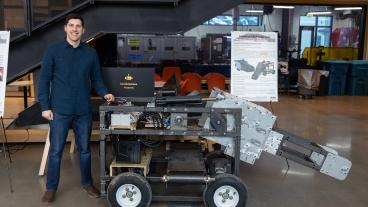This story appears in the 2014-15 issue of Mines' research magazine, "Energy & the Earth."
For those of us residing on the planet’s surface, the term “shale” evokes visions of flaking layers of rock you can all but peel away by hand. Oil and gas shale is nothing like this. Pick up a cylindrical core brought up from a reservoir two miles below – from the Bakken in North Dakota, the Niobrara in Colorado, the Vaca Muerte in Argentina, it doesn’t matter – and it’s heavy and solid like a hunk of marble. The hydrocarbons are locked inside, perhaps 100,000 times more tightly than would be the case were it merely mixed into concrete.
This is the stuff, though, of the American – and, increasingly, global – boom in unconventional oil and gas. You can’t just drop a well bore into rock like this and watch hydrocarbons gush out. You muse use advanced horizontal drilling and hydraulic fracturing technologies to release the oil and gas. Roughly one-third of the U.S. natural gas production heating our homes and fueling our factories is won this way. Two-thirds of all rigs are drilling horizontal wells. Unconventional energy, at least as applies to shale oil and gas, has become conventional.
Hydraulic fracturing has been around for decades, but we’re still learning about it. What are the true environmental impacts? How can we increase yields to bring more output per well and so have fewer wells, lower costs, cut trade imbalances and lessen the impact on the planet? Can these same techniques be applied to renewable geothermal technologies? Researchers at Colorado School of Mines are working to answer these and other questions via a broad set of disciplines and several noteworthy vehicles. Among them include the Marathon Center of Excellence for Reservoir Studies (MCERS); the new ConocoPhillips Center for a Sustainable We2st (Water-Energy Education, Science and Technology); and a new National Science Foundation (NSF)-sponsored program to understand the risks of natural gas development to the Rocky Mountain Region’s air and water.
As Mines Professor Dag Nummedal, who directs the Colorado Energy Research Institute, put it, “We really focus on making fossil energy more sustainable. That means reducing CO2 emissions, reducing methane emissions, and doing energy development in ways that allow the fossil energy industry to coexist with clean water, agriculture, breathable air and optimal temperatures.”
As part of a five-year, multi-institution NSF project, Mines researchers will focus on quantifying what those risks actually are, said Professor Will Fleckenstein. In the public arena in particular, assertions about the environmental and public health impacts of hydraulic fracturing have not infrequently outstripped their scientific basis, he added.
The projects include a study of the stresses in the cement sheaths and well casings for a better sense of what they can actually handle, he said. Fleckenstein is at the forefront of such work, having invented a technology, now ready for market, that uses a pressure test to ensure a sound hydraulic seal at depths of 300 to 2,000 feet, the zone of freshwater aquifers. The team will also examine databases relating to hydrocarbon migration for a better sense of if, how, and how often it happens.
Elsewhere at Mines, researchers will use a wind tunnel filling what used to be the Volk Gymnasium pool to better grasp how methane from natural gas production migrates through surface soils. Ground and aircraft-based sensors are sometimes finding methane hot spots with no obvious methane sources. That ground-based and air-based sensors tend to disagree on the volume of methane leaking has made the work all the more urgent, said Kathleen Smits an assistant professor. PhD student Ariel Esposito was at work on a small-scale version of the experiment at the pool’s edge. She would feed methane into the bottom of a tank of fine gravel, sand and water and detect it through sensors on top at a rate of 500 samples per second.
“It’s a really important field because there’s a lot of uncertainty about the amount of gas that’s leaking,” Esposito said. “We’re trying to lend some insights into the underlying processes.”
Meanwhile, Mines is applying its renowned strengths in reservoir characterization to boost the production of hydraulically fractured wells, which makes both economic and environmental sense. There’s a big potential upside, said Professor Hossein Kazemi, who co-directs MCERS: current production techniques only yield about 10 percent of unconventional oil, compared to 30 to 40 percent for conventional reservoirs. The work ranges from major field studies of the Bakken, Niobrara and Vaca Muerte led by Professor Steve Sonnenberg to lab experiments focusing on the nanoscale properties of reservoir rock.
As with much of the work at Mines, the research involves both experimentation and computer modeling. In one of Kazemi’s Marquez Hall labs, Mines PhD student Younki Cho has spent two years building a core flooding experiment to measure shale permeability at the nanoscale. The experiment can also inject surfactants or carbon dioxide to simulate enhanced oil recovery, he said. The stainless-steel setup was forcing pressurized brine into a 1.5-inch by 2-inch cylindrical rock core at confining stress of 2,625.7 pounds per square inch (psi) and pressure differential of 2,100 psi, producing a flow of 0.003 cubic centimeter (cc) per minute.
“It’s a very slow rate because permeability is so small,” Cho said. “You have to be very patient.”
Downstairs, PhD student Somayeh Karimi was spinning cores in an ultracentrifuge humming at 13,000 rpm. It was 420 hours into a cycle.
“Right now we have not seen any published data on direct measurement of capillary pressure with reservoir fluids in tight shale rocks,” she said. The results will feed into modeling of how much oil and gas might be recoverable, how fast, and how long that recovery might take, Karimi added.
Over in Professor Marte Gutierrez’s Brown Hall lab, PhD student Luke Frash was fracturing rocks of his own, but larger ones of about a cubic foot. Using a black-steel cell of his own design, Frash applies heat and pressure in three dimensions, and then drills into and hydraulically fractures cubes of shale, high-strength cement and granite, testing for strain, temperature, pressure, sound, even micro-earthquakes. The idea is to understand the rock-mechanical behavior of underground formations, Gutierrez said.
“It’s a scale model of what’s going on in the field,” Gutierrez said.
The granite cubes in Frash’s lab are for studies of hydraulic fracturing for renewable geothermal applications, an active field of study at Mines, said Associate Professor Bill Eustes. He and Fleckenstein are working on a project with the National Renewable Energy Laboratory to see if multi-stage hydraulic fracturing technology used in unconventional shale can be applied to geothermal energy. There are many challenges, Eustes said – among them, thicker geothermal well bores and much more heat.
These and other efforts, including work to characterize possible reservoirs for carbon sequestration and storage, illustrate how the definitions of conventional, unconventional and renewable energy are starting to blur. It’s a fascinating time to be in the energy business, Nummedal said.
“The push for sustainability is driving technology at a faster rate of change than ever before,” he said.



